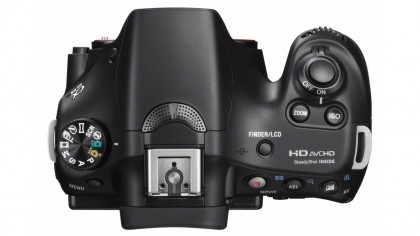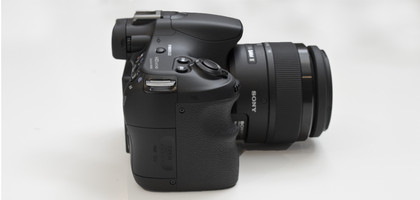TechRadar Verdict
Pros
- +
Picture Effects
- +
Low light performance
- +
Good EVF
Cons
- -
Slow autofocus
- -
Frustrating raw format use
- -
Not an articulating/touchscreen
Why you can trust TechRadar
It's been a few years since Sony first introduced its DSLT, or translucent mirror, cameras, and it seems as if consumers and the industry are now au fait with the idea. The company generally updates its entry level cameras once a year, and so it has refreshed the Sony Alpha a57 with the Sony Alpha a58.
Although outwardly the two cameras are pretty much the same, the Sony a58 now features a newly designed 20.1 million pixel sensor, compared with the Sony a57's 16.1 million pixel device.
It also features an improved electronic viewfinder (EVF), which now boasts OLED technology for improved brightness and contrast. As DSLTs, the Alpha range can only use electronic viewfinders, and as such Sony has been working hard to improve their performance.

Although some people don't favour electronic viewfinders, there are a couple of distinct advantages to using them. For starters, it's helpful to see changes you make to settings displayed in real time via the viewfinder. You also spend less time removing the camera to glance at the LCD screen as the image pops up in the viewfinder, helping you determine whether or not you've nailed the shot.
On the back of the camera is a 3-inch tilting screen. With 460,000 dots, it's a fairly low resolution screen when compared to other beginner models currently out there on the market, such as the Canon EOS 100D. It's also not touch-sensitive, which although unfortunate, perhaps would have pushed the price up too far for the target consumer.
Talking of price, the Sony a58 currently costs £449 / US$599.99 / AU$799 with a newly designed 18-55mm kit lens.

The camera uses a 15-point AF system, which includes three cross-type sensors. It is capable of shooting at 8fps in telezoom continuous advance priority AE mode, or at 5fps at the camera's highest resolution, giving it one of the fastest burst rates currently in the entry-level market.
Sign up for breaking news, reviews, opinion, top tech deals, and more.
Sony is targeting this camera both at those with compacts looking to make their first step into the DSLR/T interchangeable lens market, as well as those with existing entry level DSLRs looking for a replacement.
Another new feature, which is particularly interesting, is Auto Object Framing, a step-up from the Auto Portrait Framing system that made its debut last year. Now not only can the camera automatically crop portraits for better compositions, it can also do it with objects, including macros and moving subjects.

As befits the intended consumer of this camera, Sony has included a number of fun and simple features. These include Sweep Panorama, a feature first outed in the company's range of Cyber-Shot compacts, and a range of Picture Effects and Picture Styles.
Another feature that may be particularly appealing is Clear Zoom - Sony's name for its digital zoom. This uses By Pixel Resolution Technology, which is designed to double the effective focal length of whichever lens you're using, while maintaining the same resolution. Those customers who don't want to purchase additional lenses may find this is especially useful.
One of the benefits of the translucent mirror is that the camera can deliver autofocus during fast burst speeds. The camera is capable of shooting at up to 8fps, which is pretty high for an entry-level camera, certainly beating the Canon EOS 100D, which is capable of 4fps.

Along with the wide number of lenses already available for the A-mount, Sony is launching three new lenses at the same time as the Sony Alpha a58. First up of those is a new 18-55mm kit lens, which will be bundled as part of the Sony a58 kit package.
Sony is including the 18-55mm kit lens as standard with the Alpha a58, which covers an equivalent focal length of 27-82.5mm in 35mm terms. Although Sony doesn't have quite the proprietary lens range of Canon and Nikon, the number of A-mount lenses now tops 50, with seven premium optics available manufactured by Carl Zeiss.

Amy has been writing about cameras, photography and associated tech since 2009. Amy was once part of the photography testing team for Future Publishing working across TechRadar, Digital Camera, PhotoPlus, N Photo and Photography Week. For her photography, she has won awards and has been exhibited. She often partakes in unusual projects - including one intense year where she used a different camera every single day. Amy is currently the Features Editor at Amateur Photographer magazine, and in her increasingly little spare time works across a number of high-profile publications including Wired, Stuff, Digital Camera World, Expert Reviews, and just a little off-tangent, PetsRadar.
